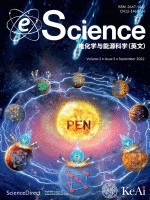Chuai Mingyan,
Yang Jinlong,
Wang Mingming,
Yuan Yuan,
Liu Zaichun,
Xu Yan,
Yin Yichen,
Sun Jifei,
Zheng Xinhua,
Chen Na,
Chen Wei
2021, 1(2): 178-185.
doi: 10.1016/j.esci.2021.11.002
Abstract:
Electrolytic MnO2/Zn batteries have attracted extensive attention for use in large-scale energy storage applications due to their low cost, high output voltage, safety, and environmental friendliness. However, the poor electrical conductivity of MnO2 limits its deposition and dissolution at large capacities, which leads to sluggish reaction kinetics and drastic capacity decay. Here, we report a theory-guided design principle for an electrolytic MnO2/Zn battery co-regulated with transition metal ions that has improved electrochemical performance in terms of deposition and stripping chemistries. We start with first-principles calculations to predict the electrolytic effects of regulating transition metal ions in the deposition/stripping chemistry of the MnO2 cathode. The results indicate that with the simultaneous incorporation of strongly electronegative Co and Ni, the MnO2 cathode tends to possess more active electron states, faster charge-transfer kinetics, and better electrical conductivity than either MnO2 regulated with Co or Ni on their own, or pristine MnO2; hence, this co-regulation is beneficial for the cathode solid/liquid MnO2/Mn2+ reactions. We then fabricate and demonstrate a novel Co2+ and Ni2+ co-regulated MnO2/Zn (Co–Ni–MnO2/Zn) battery that yields significantly better electrochemical performance, finding that the synergistic regulation of Co and Ni on MnO2 can significantly increase its intrinsic conductivity and achieve high rates and Coulombic efficiencies at large capacities. The aqueous Co–Ni–MnO2/Zn battery exhibits a high rate (10C, 100 mA cm–2), high Coulombic efficiency (91.89%), and excellent cycling stability (600 cycles without decay) at a large areal capacity of 10 mAh cm–2. Our proposed strategy of co-regulation with transition metal ions offers a versatile approach for improving the electrochemical performance of aqueous electrolytic MnO2/Zn batteries in large-scale energy storage applications.




